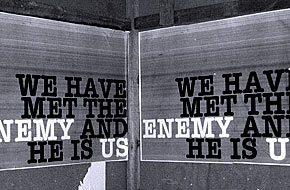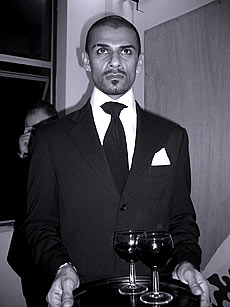|
Press Release
'WE HAVE MET THE ENEMY AND
HE IS US...' is a group exhibition,
initiated and curated by Shezad Dawood in association with
Redux.
Artists: Babak Ghazi,
Mustafa Hulusi, Rasheed Araeen,
Reza Aramesh, Runa Islam,
Shezad Dawood and Andy Seize.
My friend Ahmed, up until September
11, always claimed to be from
Afghanistan (rather than Pakistan),
as this seemed to give a more heroic and romantic slant to
his origin. Relating him,
by proxy, to the grizzled warriors
of the Mujahadeen, who alone
had fought off the Soviet invaders.
The real extending by proxy,
into dialogues of identity and origin,
and therefore proving itself merely the image of a thing to
be plucked and used as accessory-sign.
This extension and appropriation of a supposed 'truth',
itself operating around a thin confluence of borders and signs,
becomes the performative flipside to Taliban-chic.
So why stop at September the 11th?
From ethno-religious group
shows, to coalitions of the
willing. Exclusion,
rather than inclusion seems to be the new diversity,
borne out by cultural institutions as much as by the World
Bank. In fact it is corporations,
in an odd twist of fate that seem the most inclusive.
Not being answerable to anyone,
they are happy to take your money no matter who you are.
After the gains of the early 90s,
mediaevalism seems to be the new black.
Despite the promise of hybrid spaces,
and metissage as cultural practice,
borne out of the legacy of cultural theory,
it seemed suddenly that no one wished to see this trajectory
through to its logical conclusion.
As with protectionist markets,
entrenched positions were good for business -
and without guilt funding would possibly be a meritocratic
free-for-all.
A situation that would do nobody any good.
And yet this has left those artists on the threshold of these
hybrid spaces, those artists
who are able to reflect the fluid spaces that are slowly collapsing
the old social order, out in
the cold. In this way one
might see a complicity between the centre
|
and its other,
to squeeze out any attempts to bridge that gap and tear away
the illusion and neurotic compulsion of alterity forever.
Mediaeval Islam colludes with Fundamentalist America in a
pact in which there is no Devil, as
the evil is purely human and selfish:
'"Come
on,"
the captain said, "we'll
take you out to play Cowboys &
Indians"'
[i].
I remember as a kid always having to be the 'Indian'
in the schoolyard. Yet part
of this identification was always built on an unspoken desire
to be a cowboy. There would
have been no issue, if my school-friends
were not implicitly aware of my heart's
desire. The desire imposed
by any border. Especially where
such a border conferred the status of the normative:
day entry to England's Green
& Pleasant Anglo-Saxon
gene pool. Yet as Derrida would
have it: "there
is a problem as soon as the edge-line
is threatened. And it is threatened
from its first tracing. This
tracing can only institute the line by dividing it intrinsically
into two sides. There is a
problem as soon as this intrinsic division divides the relation
to itself of the border and therefore divides the being-one-self
of anything." [ii]
So what of those artists who lay claim to both sides of the
equation, and neither simultaneously?
Perversely we might lay claim to the only genuine case for
universalism, in that we cause
problems for both Us &
Them, by exploding any such
narrow or fixed readings of culture.
We, in a sense are the ghost
in the machine, presenting
the troubling range of our experience with all the objectivity
of a Greek chorus. We don't
want to be you, or your other
- please leave your sociopathological
neuroses at home.
i. Michael Herr, "Dispatches".
ii. Derrida, Jacques: "Aporias",
Stanford University Press, Stanford 1993.
[ Events ]
[ Photos ]
|













